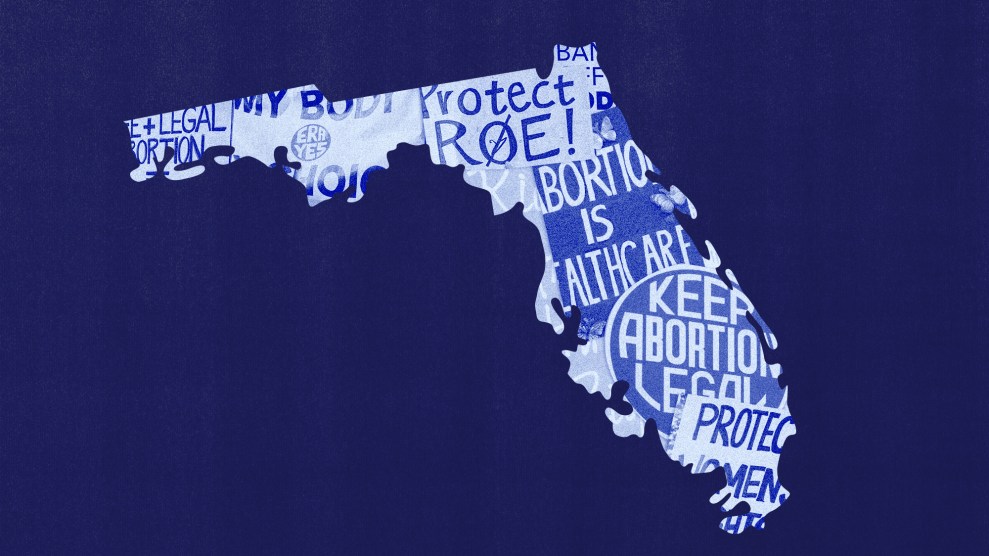For those seeking abortions in the state of New York, little should change if the Supreme Court overturns Roe v. Wade, at least in theory. Abortion access is enshrined in the state’s code of law—it’s illegal there to deny someone the right to terminate a pregnancy. Just after the draft opinion on abortion was leaked, Gov. Kathy Hochul tweeted, “For anyone who needs access to care, our state will welcome you with open arms. Abortion will always be safe & accessible in New York.”
Yet in the small town of Brighton, New York, a progressive and well-heeled suburb of Rochester, anti-abortion activists are employing a novel tactic to try and change that. With the help of national legal strategists, the local group Brighton Residents Against Violence to Everyone, along with other anti-choice groups and individuals, have made the case that a proposed Planned Parenthood clinic poses a threat to the character of the community—and, interestingly, to its waterways. It claims that because the facility will prescribe abortion medication, it will pollute area waterways with the remains of aborted fetuses flushed down toilets. By failing to consider this and other effects on the community, the group alleges, the town planning board didn’t properly follow local or state environmental law.
Reproductive rights experts told me that BRAVE’s arguments are unheard of and aren’t based on evidence or science, and that some of their bizarre claims constitute disinformation. As Michelle Casey, president and CEO of Planned Parenthood of Central and Western New York, told me, the opposition against the Brighton Planned Parenthood sets a new bar for inflammatory rhetoric: “I think it’s the most extreme that I’ve seen at our affiliate,” she said. “It’s really just beyond the pale.”
Still, the fight in Brighton portends another ominous front in the assault on abortion rights—or at the very least a new way to harass already beleaguered abortion providers. Construction plans for the clinic are currently on hold because Planned Parenthood’s lease was canceled over a financial dispute, though BRAVE and allied anti-choice activists are claiming it’s a victory of their own making. And as such, they are bragging about BRAVE’s environmental and community-focused tactics as an innovative legal strategy, a model for how to fight against abortions in states where the law is unlikely to change even if Roe is overturned.
The fight over Brighton’s Planned Parenthood began last spring, when the town planning board announced the proposal for the clinic and opened a public comment period. At the board’s Zoom meetings, dozens of residents showed up to voice their opinions. Some welcomed the idea of a new clinic in town—in the shadow of the University of Rochester, with its highly regarded medical school, Brighton had always had first-rate health care facilities. Others weren’t so wild about the idea. Some spoke about their belief that life begins at conception, and how they therefore considered abortion to be morally wrong.
But beyond these typical lines, their arguments fell into two particularly inflammatory categories: that the clinic would devastate Brighton’s water and environment, and that it would enable sex trafficking in the town’s backyard.
The idea that the clinic would be a stain on the community, no matter what Brighton residents believed about abortion, came up during the public comment period at several of the early meetings. During a June 16, 2021, Zoom meeting, for example, a commenter named William said that he objected to the clinic on environmental grounds; he was concerned that in order to deal with medical waste, the clinic would need to build an incinerator and expand the sewage system. “I think the environmental considerations need more study,” he said. At subsequent meetings, other residents repeated these ideas.
Then, in August, BRAVE and another anti-abortion group filed a lawsuit against the planning board that pushed their community arguments a step further, formally alleging that the board hadn’t examined the environmental or safety impacts of the clinic on the town. “By failing to consider the environmental disamenities of the project, in terms of public safety, traffic, and disposal of waste, including the handling of fetal remains,” the complaint stated, “the Planning Board failed to perform duties enjoined upon it by law.” The lawsuit also claimed that the board hadn’t reviewed how the building would be used, and that it had therefore violated New York’s State Environmental Quality Review Act.
Some of the content in the lawsuit seems designed to appeal to Brighton’s progressive residents, the kinds of people who might fight for the cleanup of local wild spaces and waterways. Lynn Howlett, who is identified in an affidavit as “a New York citizen and resident who has constitutional rights to clean water,” argued that patients who are prescribed abortion pills to take at home would flush their fetal remains in the toilet and pollute the local waterways. These remains, she said, would be “too small to be caught by the screening that would normally catch a dead animal or larger section of human tissue,” Howlett wrote. “If, in a given day, twenty such fetuses are flushed into the Town’s wastewater treatment systems, it would be the equivalent of a shredded forearm or foot being passed through the system—small enough not to be screened out but cumulatively representing a sizeable amount of human body parts.” In an email, BRAVE’s lawyer, Linda Mandel Clemente, said that the plaintiffs were also concerned that the hormones in the abortion medication would pollute the town’s water, and that these concerns taken together warranted further study by the planning board.
The experts on abortion policy and practice that I spoke to all said they were stunned by the outlandishness of these arguments. They were particularly appalled at the idea that medication abortion could somehow affect water quality—it wasn’t an argument they had heard before. “That is so far outside of the realm of reality,” said Elizabeth Nash, a principal policy associate with the pro-choice think tank the Guttmacher Institute. Daniel Grossman, an OB/GYN who studies family planning at the University of California-San Francisco, was equally shocked. “Wow,” he said. “I don’t even know what to say about that, other than that patients miscarry all the time at home”—with no deleterious effect on the sewage or wastewater treatment systems.
Sasha Harris-Lovett, a water infrastructure researcher with the University of California-Berkeley’s Water Center, agrees. “I can confidently say that raising children has WAY more of an effect on the sewer system—in terms of bodily fluids and tissues, laundry detergents, and other household chemicals, and the occasional Batman figurine down the toilet—than deciding not to have children,” she wrote to me in an email. “That being said, wastewater treatment systems are designed to deal with human wastewater.” Casey, the local Planned Parenthood president, noted that none of the other clinics in the region had been required to undergo an environmental review.
Meanwhile, another bizarre argument against the clinic was gaining steam. At a July 14 meeting, this one held in person, a resident named Cecelia said that she believed that Planned Parenthood would pose the same kinds of problems as a strip club or an X-rated movie theater: “the attraction of transients, parking, and traffic problems, and loss of business for surrounding businesses.”
A week later, at a July 21 in-person meeting, the anti-abortion activists showed up in force—25 of them spoke at the podium. Many pointed to the planning board’s duty to uphold the quality and character of the town, which they believed a Planned Parenthood clinic would diminish. One speaker, a Brighton resident named Paul, said he was concerned that unsavory characters would use public transportation and ride-sharing services to come to Brighton’s Planned Parenthood and “loiter.” He said he worried about them playing loud music, “smoking tobacco and marijuana, which is now becoming very prevalent.” He speculated that Planned Parenthood could put up “large, neon signs that do not fit with the community.”
Then, in an affidavit in support of its lawsuit, BRAVE president and Brighton resident Carol Crossed decried the planning board’s “failure to consider the deleterious secondary effects wrought by the sex traffickers who frequent such facilities as the Project and engage in lewd and obnoxious behavior damaging to the children attending the school, the Muslims attending and praying at the neighboring mosque, and the children playing in the nearby playground.” Mandel Clemente said in an email that members of the group have “experienced women and men driving by the abortion clinics, honking horns and shouting obscenities and pulling up shirts to flash bare breasts.” For these reasons, she believes the planning board should have done a study “designed to address similar concerns arising out of adult entertainment businesses.”
Although victims of trafficking do often seek abortions, there is no credible evidence that clinics themselves promote trafficking or lead to crime in their surrounding communities. The idea has nevertheless gained momentum over the past few years, as it’s been promoted by right-wing think tanks like Focus on the Family. In conspiracy circles, it’s taken on an even darker twist. In a 2021 Rolling Stone article, journalist Sarah Posner chronicles how Planned Parenthood became a bête noir for adherents of the QAnon conspiracy theory, many of whom believe that a shadowy underworld of intellectuals feasts on the blood of terrified children. A former anti-abortion activist told Posner, “I get messages from my old crowd saying, ‘Rob, how can you support baby eaters?’ It’s gone to actually baby eating. You know that people at Planned Parenthood, Hillary Clinton, and her cabal, they don’t just kill infants. They eat them.”
Grossman said that he’s also recently encountered some wild strains of disinformation around sexual violence and abortion. Last year, he served as an expert witness for a trial during which a pro-life doctor made the baseless claim that some types of sexual abuse could only be detected through a pelvic exam—so medication abortion prescribed via telehealth instead of a clinic visit would actually allow abuse to go undetected. “It was absolutely horrifying,” Grossman said.
Before the suit could be litigated, Planned Parenthood’s plans were halted—though the reason why had nothing to do with BRAVE. In January, Brighton Planned Parenthood said that its lease had been canceled, which Casey emphasized had to do with an unexpected increase in the rent and was completely unrelated to the lawsuit.
Still, BRAVE dissolved its lawsuit within a few days and issued a press release proclaiming, “Brighton Residents Against Violence to Everyone (BRAVE) prevails in stopping construction of a 6500 square foot abortion clinic.” News of BRAVE’s supposed triumph spread quickly through the US anti-abortion movement. A glowing article on the website of the anti-abortion group Thomas More Society praised BRAVE’s efforts, saying its lawsuit “focused on the site plan approval process itself, including the lack of a meaningful review by the Planning Board of the many issues that an abortion clinic can bring to a neighborhood community.” It also noted that Reprotection, a national group that aims to shut down abortion clinics, helped BRAVE craft its legal strategy. In February, Missy Martinez-Stone, CEO of Reprotection, told the anti-abortion news site Pregnancy Help News, “We look forward to taking this precedent-setting lawsuit to other cities and towns across the country.” The pro-life group Life Issues Institute called BRAVE’s work “a novel blueprint for success.”
While it’s unclear if anyone else will pick up their tactics and try them in court, it’s easy to see how the newly emboldened anti-abortion movement might try out what were once considered fringe arguments in the coming months. For her part, Casey worries that the rhetoric the group used will be repeated, as pro-life groups seek to chip away at abortion access in places where the reversal of Roe won’t make abortion illegal. She said she has seen a dramatic uptick in disinformation around abortion, and that the trend toward extremism could very well threaten providers’ safety. “People actually believe that things that they’re saying,” she said. “That could cause people to do things that would be dangerous.”
















